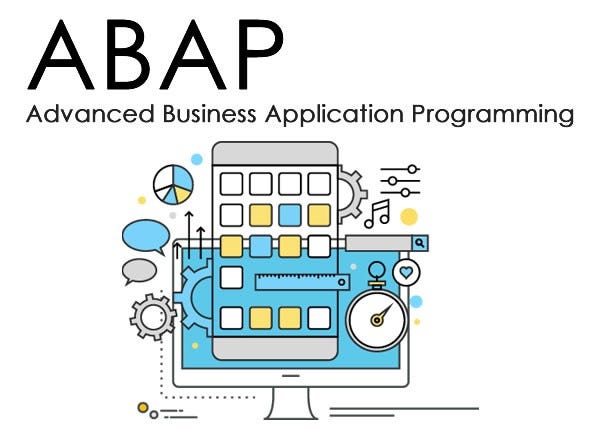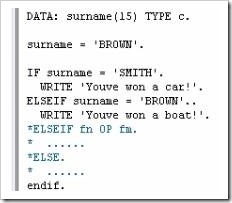ABAP
Being able to control what a computer does is seen as a modern-day superpower. All computer applications and apps on our cell phones run on programming languages. Coding is the act of using these languages. If someone wanted to create an app for our phones, they would have to learn how to code. All of the apps we see today as Instagram and Spotify run on programming languages. When it comes to programming languages, there are tons to choose from. For example, there is Java which is popular and is a multi-purpose language. Multi-purpose meaning it can be used for many different applications and purposes. Another example of a programming language and the language which we will be discussing today is called ABAP. Contrary to Java, ABAP focuses mainly on developing business applications and is not multi-purpose.

ABAP was created by a German company called SAP. ABAP is a high-level programming language. ABAP was extracted from many popular languages including Java, C, C++, and Python. ABAP is an acronym for Advanced Business Application Programming and was developed in the 1980s. ABAP was originally developed as a business tool for the R/2 platform of SAP. ABAP is a required language for developers that want to work in Data & Analytics, sales, product management, and much other business-related software. But to fully understand the function and purpose behind ABAP, we must look at the SAP system.
SAP
Like I stated earlier, SAP is the German company that developed ABAP. But to understand ABAP, it is important to also understand SAP and its purpose. SAP is a software company that creates applications to help business owners. These business applications use advanced technology analytics to help businesses around the world stay organized. Sap helps these businesses perform at their best. SAP customers can use ABAP to modify the function of SAP applications or develop their own on the Sap NetWeaver platform. SAP developed ABAP to help create and also enhance SAP applications. ABAP is known to be flexible and give users a lot of control over the applications. ABAP allowed users to create and customize reports, as well as interact with the ABAP programming itself. Now that we know a little about SAP and ABAP, let’s look at the history of ABAP.
History of ABAP
ABAP was released in 1983 as a procedural programming language. 30 years after the first procedural programming language Fortran was born. APAB object was released in 1999 as an object-oriented language. At one point, ABAP represented a large reporting processor in Germany. ABAP originally was an acronym for Allgemeiner Berichts Aufbereitungs Prozessor, which translated to general report preparation processor. As ABAP evolved through the years and changed its nature, the meaning of “ABAP” also changed to Advanced Business Application Programming. This is a valid change of name because ABAP’s old name did not fit the job of the current model.
ABAP was the first report language for the R/2 platform from SAP. It allowed large companies to develop mainframe business applications for material and financial management. SAP also allows ABAP users to control SAP applications to their liking. Customers were allowed to use custom reports and interact with the ABAP programming. ABAP is now the language that develops programs for the client-server sap R/3 system. All of these factors were a recipe for success for ABAP.
Platforms
A software platform is defined as “a set of software and a surrounding ecosystem of resources that helps you to grow your business”. A software platform is a software that is used to host an application. Some really popular examples are Microsoft Windows, iOS, and Android. As I mentioned before, at ABAP’s first release in 1983, it was used as a report language for the R/2 platform. SAP would later go on to create the SAP Cloud Platform that runs on ABAP. The SAP Cloud Platform is a platform service that provides an environment for runtime and development for cloud applications. According to Searchsap.com SAP Cloud Platform allows independent software vendors, startups, and developers to create and test cloud applications. SAP says that their platform uses next-generation technology to organize existing applications and expand on them.
Benefits
ABAP is a very good language to learn, especially if someone is trying to develop an SAP application. It makes sense to use SAPs own language to create SAP applications. To break down what makes ABAP a good language, let us look at the benefits. ABAP is an event-orientated language, meaning that it requires user interaction and does not start and stop on its own. This allows the user to have a lot of control over ABAP. With that being said, ABAP is always at the top for business management languages. SAP and ABAP provide ligament and effective methods to define, manage, and manipulate databases. ABAP can be mapped onto any virtual objects and can be called open whenever it is needed. The ABAP language also allows an incredible amount of flexibility to SAP applications, causing ABAP to change the database and create its own rules within its structure.
Downsides
Although ABAP is a crucial language for business and organization, it comes with a fair share of negatives as well. For example, ABAP is not an all-purpose programming language. Languages like Java, C#, and C++ are and you can do a lot of diverse things with those languages. But ABAP is relatively connected with SAP and follows the platform which is laid out. I feel like that makes sense as ABAP was designed with a purpose in mind, and SAP built their whole business software around ABAP. ABAP shouldn’t be seen as a general programming language but only as a business development language. ABAP fits that business role very well. ABAP will allow you to develop business applications very easily. Regardless, ABAP will not allow you to expand out of that and develop things like games and social applications. To me, that seems like a valid trade-off as ABAP was developed with a business purpose in mind.
ABAP Object
In 1999, SAP released ABAP Objects. This was an extension to the first ABAP, which was already up and running. Up until that point, ABAP was only a procedural language. SAP wanted to expand on ABAP furthermore and give ABAP more object-orientated functions. Sort of like putting the icing on a cake, SAP was improving an already exceptional language. ABAP objects, also known as OOABAP (object-oriented Advanced Business Application Programming) are said to have cleaner syntax and semantics rules. Object-oriented programming allows users more options to work with. Object-oriented programming focuses on values stored within objects. Object-oriented programming is easier to understand as the code resembles real-life operations. Though ABAP is still a valid option, you will have to use ABAP objects to access the new technology of ABAP. This means that no matter what, you will most likely run into ABAP objects if you get into ABAP. Furthermore, ABAP Objects gives ABAP a full set of language elements and expands on the capabilities of ABAP.
Examples of code
If statements
In the programming world, If…Else statements are a series of codes that are only active if a certain statement is true. If the first expression is true then the If code that is under that statement will execute. If the expression is false, the Else code will execute. For example, a programmer could ask for a user’s age and print a statement that determines if they are of legal age to drive a car. This would look like: if x is greater than or equal to 16, print out the statement “old enough to drive”. With X being the user’s age. The Else statement will only activate if the If statement is not true. From our example, if the user’s age (X) is less than 16, the program will run the Else statement. We can print out a statement like “not old enough to drive” if that happens. Now that we are familiar with If statements, let’s take a look at ABAP code.

In this example, we see in line 2 that the surname is “Brown”. In line 3 we begin our if statement and check if the surname is “smith”. That is false so we go down to the second If statement on line 5 which is true. Since the second if statement is true we run the code that is associated with that statement. The code asks us to write “You’ve won a boat!”. From this example of an If…Else statement in ABAP, the output will be “You’ve won a boat!”.
Loops
In the programming world, Loops can get a little confusing but tend to be very useful. In ABAP, there are 2 major types of Loops. Unconditional loops are one of them using the DO statement and Conditional loops using the WHILE statement. Both of these statements work in similar ways. Loops statements run a code block a handful of times in sequence (meaning back to back, and how many times depends on the type of Loop). Let’s look at one of these Loops, specifically unconditional loops.
Unconditional Loops follow this structure below:
DO [n TIMES] …
[statement_block]
ENDDO.
Let’s break this down for a better understanding. Unconditional Loops repeat a certain amount of times depending on the code that is put for ’n’. When the code has run n number of times, it will stop running. Here is an example of what this would look like in a real application.

This is a very simple example of an unconditional loop. Here we have 15 as our n, meaning the code will repeat 15 times. Looking at the code block under our statement, we are asked to print out “Hello.”. And since we are repeating that code 15 times, we will print out “Hello.” 15 times in succession. It will look like this:
Hello.
Hello.
Hello.
12 more times until we have done it 15 times.
Trends
ABAP’s golden years seem to be behind it. Nevertheless, it is still a relevant programming language used in many SAP applications. Since its release, ABAP has seen a lot of development and evolution. That is due to the development of computer hardware and software in the 1990s. ABAP was released in 1983 and advanced in usage. By 2001, ABAP had been used to write almost all the functions for SAP, leaving out only the basic ones.
Takeaway on ABAP
In conclusion, ABAP is SAP’s default programming language for their applications. ABAP is an easy-to-use programming language that is used for business applications. Even though ABAP is used for business applications only, that doesn’t make it any less a programming language. ABAP was created in 1983 and has evolved a lot throughout the years. ABAP’s success is partly because it was the first language to use the logical database concept. If you are ever interested in working on ABAP, SAP offers jobs to developers who are willing to work with ABAP. These programmers are referred to as ABAP consultants. ABAP consultants need to be creative and face adversity. ABAP consultants are heavily needed and are a very rewarding career. Would you want to be an ABAP consultant?
